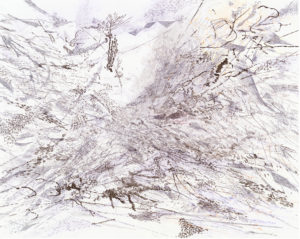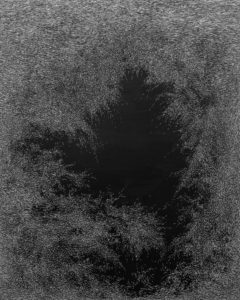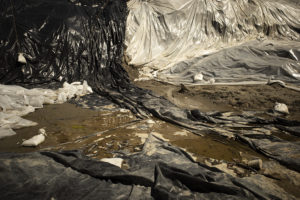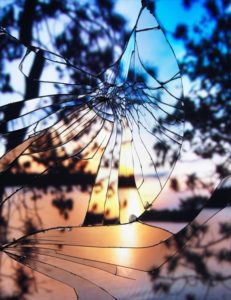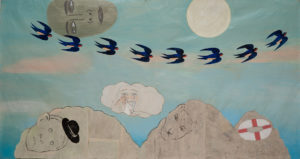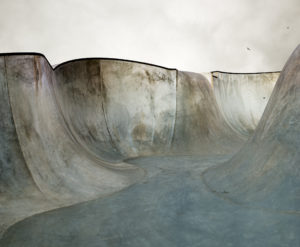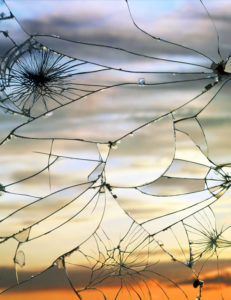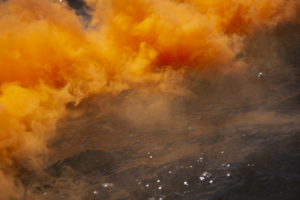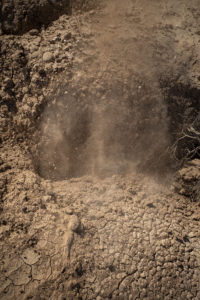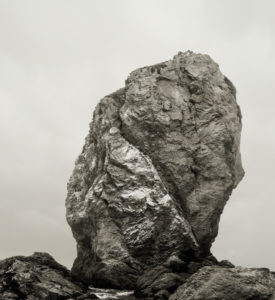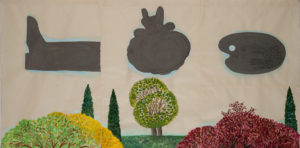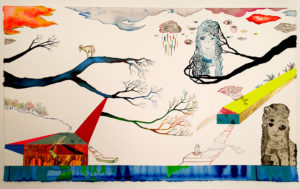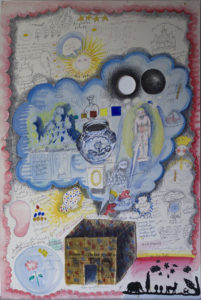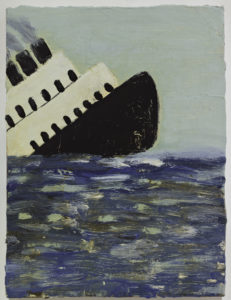November 13, 2021—January 8, 2022 | Online Exhibition
James Harris Gallery is pleased to present “Site Insight” an exhibition that explores how artists use and interpret site as a position or location especially as to its environment. This show considers how some artists interpret site in a more literal term while others use it allegorically. The disparate works act like instruments in an orchestra pit. Individually, they are decisive works but taken in unison they reveal the emotional power works of art can have on a broad range of subjects and human character. Beauty is seen through ugliness and vice versa. All the works enlighten the viewer to the complexity of the world in which we live. The artists included in the show are: Squeak Carnwath, Claire Cowie, Fay Jones, Julie Mehretu, Jeffry Mitchell, Mary Ann Peters, Luke Kempton Williams, Bing Wright, and Amir Zaki.
Julie Mehretu’s print “The Residual” is composed of intuitive marks inspired by migratory maps, geography, blue prints and other patterns. They are often seen as interpretations into layers of history and how civilizations and communities are often buried under layers of human existence. Mary Ann Peters piece ‘this trembling turf (the hollows)” shares in the intuitive notion of site and how cultural histories are hidden. Inspired by the sonic pulses of forensic anthropology, Peters’ mark making explores how civilizations are often built over one another during times of conflict. Luke Kempton Williams photograph titled “Earth” is a more direct interpretation of site. The image depicts an abandoned construction site along a hillside. Black and clear vinyl tarps stabilize from erosion. The natural landscape has been erased leaving only the history and preservation of man’s destruction. In Claire Cowie’s watercolor titled “South Beacon Hill No. 3,” two electrical towers monumentally stand in a blank landscape. Painted in brightly hued geometric pattern, the towers become totems of our energy dependence that fuels our consumer culture. But in a compositional element that covers one quarter of the right side from top to bottom of paper, she has filled the rectangular area with washes of chartreuse punctuated with black ink. has juxtaposed against these beacons of clean energy, could this be an insightful comment on the pollution of fossil fuels? Bing Wright offers us moving skyscape photographs of richly colored sunsets reflected onto broken mirrors. The tranquility and beauty of the setting sun is now compositionally fractured and distorted in “Broken Mirror/Evening Sky(Agfachrome)” The violence of the smashed mirror is transformed into a comment on the fleeting nature of time. “Memento Mori” by Fay Jones is a symbolic and cathartic presentation of loss and grief, hope and joy. This large-scale work on paper is a psychological landscape incorporating symbols the artist has repeated throughout her artistic career. Water, a common theme, is presented as tears of grief while also serving as a life force and symbol of growth. A moon rises above hills scattered with images of a life preserver, mountain lion’s face and the silhouetted visage of a man with a hat. All personal symbols that give insight into the artist’s life story of creativity and family. Amir’s Zaki’s photograph “Concrete Vessel No. 63” at first appears as a dystopian landscape devoid of human activity. Upon closer inspection, the tread marks of skateboards reveal an active space now empty. Photographed in the early hours of the morning, the empty skate parks become monuments to youth culture. In “Good Luck,” the painting becomes the site for an open ended narrative performance by Squeak Carnwath. The artist’s handprints punctuate the surface along with symbols representing luck. A rabbit, an iconography in for fecundity, stands on the right side gazing at Rorschach inkblots. The artist has denoted an oval portion a “guilt free zone.” A reference to the Iraq War is written on the ruled sheet of paper. Carnwath’s compositional elements are clues into a mindscape. Perhaps the “guilt free zone” gives us permission to escape from the horrors and atrocities of war.
The eighteen works in this exhibition explore an interest in site. Each artist intuitive interprets site as a psychological or emotional response to place. Often the image is rooted in reality; alternatively it can also be a fictional composite in which the idea of a location goes beyond the physical aspect a specific place. The artworks allude to the complexities and interconnectedness of human experiences but lets us chart our own journey to discovery.
Luke Kempton Williams
Luke Williams depicts what he sees as his United States. United in its states of struggle and hope as a nation but also the integration of his homosexuality and the perceived antithesis of queerness in blue collar culture. His photographs draw attention to and survey objects of personal note, often disparate or disconnected but linked through progressive sequences that induce cinematic storytelling. Each image though powerful on its own serves to amplify the arching themes of his narratives.
Williams is the founder and publisher of the magazine Cave Homo, which focuses on queer creativity and inclusion. It expresses an alternate outlook on LGBTQIA+ life, influences, identity and culture, different than the image of the community portrayed in media and advertising. Cave Homo serves as a beacon to those who don’t feel they fit within the confines of traditional queer archetypes and offers a fresh crop of artists, performers, musicians, writers, photographers and other creative outsiders to encourage, validate, and inspire Queer freedom, pride and excellence.
Born in 1983 and raised in Olympia, Washington, Luke Kempton Williams is a queer multi-disciplinary artist whose practice includes photography, video and sculpture. He lives and works between New York City and the Oregon Coast.
Squeak Carnwath
Squeak Carnwath is a painter and printmaker who uses text, color field painting, and a wide variety of recognizable symbols to make interesting, engaging, and relatable works. Her works have the intimate feel of a diary, but acknowledge universal themes that are familiar to every viewer. Her paintings work together to form a kind of visual conversation within the spaces that they are displayed. Carnwath utilizes traditional painting techniques such as trompe l’oeil and symbolism, while also making statements that question the viewer’s thoughts and emotions. Carnwath wants the viewer to make connections between words, objects and shapes; connections that often evoke moments of humor and sadness. Carnwath currently lives and works in Oakland, California.
She has received numerous awards including the Society for the Encouragement of Contemporary Art (SECA) Award from San Francisco Museum of Modern Art, two Individual Artist Fellowships from the National Endowment for the Arts, a Guggenheim Fellowship and the Award for Individual Artists from the Flintridge Foundation. Carnwath is Professor Emerita at the University of California, Berkeley.
Claire Cowie
Claire Cowie uses a variety of media to reference the natural world around her home in Seattle, as well as around the world. Cowie utilizes symbols of the natural world such as birds, insects, and a variety of plant-life, as well as heavily using the negative space in a work. By using watercolor and ink in the areas around her subject Cowie references the fragmentation between the natural world and us, as well as of memory. The colors and shapes in her work create dream-like landscapes that pull in characteristics of urban architecture.
Claire Cowie lives and works in Seattle, Washington, where she is a lecturer at the University of Washington. Cowie attended both the North Carolina School of the Arts (Winston-Salem, NC) and Washington University in St. Louis (St. Louis, MO). She received her MFA from the University of Washington (Seattle, WA). Cowie’s work has been exhibited both nationally and internationally, including shows at the Henry Art Gallery (Seattle, WA), Takeda Biennial (Oaxaca, Mexico), Tacoma Art Museum (Tacoma, WA), Frye Art Museum (Seattle, WA), Shenzhen Art Institute (Shenzhen, China) and the Art Gym at Marylhurst University (Lake Oswego, OR). Her work is included in the collections of the Henry Art Gallery (Seattle, WA), Microsoft Corporation (Redmond, WA), Safeco (Seattle, WA), and Tacoma Art Museum (Tacoma, WA), among others.
Bing Wright
Wright has always been fascinated by the correlation between the photo and a mirror, both being silver based picture planes. At the beginning of his artistic career, Wright was exposed to the potential of the medium by John Szarkowski’s legendary exhibition Mirror and Windows in 1978, which reconstructed the framework of the photographic image as a two-dimensional pictorial surface into a conceptual space. With a postmodern perspective of the photographic image, the medium expanded into diverse practices that continue to reorient our relationship to photography.
Bing Wright was born in Seattle in 1958 and received a Bachelor of Arts in Art History from Columbia University, New York. His work been shown in exhibitions at the New Museum, New York; White Columns, New York; the Queens Museum of Art, New York; and the Tang Museum and Art Gallery, Saratoga Springs, among others. His work is in several public collections, including The Museum of Modern Art, the Portland Art Museum, the Seattle Art Museum, Goldman Sachs, JP Morgan Chase Bank, and Citigroup. Wright recently curated an exhibition of 1970s photography from the collection of the Washington Art Consortium. He lives and works in New York City.
Amir Zaki
A firm believer in the transformative power of the photographic image, Zaki images are rooted in the history of the medium and uses it to shed light on the means of representation. Over the last 16 years, Zaki has pushed the physicality of the photograph’s two dimensional construct, allowing it to exist on its own and also exploring its own object-ness. In order to capture and record the original site, Zaki’s representations depict the complexity of place in terms of interactive evolving experience, an ongoing ecological intervention. The artist responds to the shifting contemporary landscape where nothing is permanent, constructing his own visual language to illustrate an entire mythology of place.
Amir Zaki lives and works in Southern California. He received his MFA from UCLA in 1999 and has been exhibiting nationally and internationally since graduating. He is a full professor at the University of California at Riverside. His work is included in many museum collections including the Hammer Museum of Art, Los Angeles County Museum of Art, New Museum of Contemporary Art, Orange County Museum of Art, Santa Barbara Museum of Art, and the Whitney Museum of American Art, among others.
Fay Jones
Fay Jones’ work conveys the intimacy of mind, emotion, and spirituality. As a whole, Jones’ paintings echo a tremendous sense of humanity. The pieces meld figures, animals and symbols to conjure up existential meaning of human experience. Her characters become signifiers, representing the watery depth of the unconscious.
Fay Jones received a BFA from the Rhode Island School of Design in 1957. Awards she has received include the Joan Mitchell Painters and Sculptors grant in 2013, the Seattle Art Museum’s 2006 Poncho Artist of the Year award, grants from the NEA in 1983 and 1990, the Washington State Arts Commission in 1984, and La Napoli Art Foundation in 1989. Her work has been extensively collected in the Northwest, and is included in the collections of the Portland Art Museum and the Hallie Ford Museum of Art in Oregon, and the Seattle Art Museum and the Tacoma Art Museum in Washington, as well as the Cities of Seattle and Portland. Major exhibitions include a 2007 retrospective at the Hallie Ford Museum of Art at Willamette University, a 1997 traveling retrospective with the Boise Art Museum, and exhibitions at the Portland Art Museum, the Seattle Art Museum, the Museum of Northwest Art in La Conner, WA, the Anchorage Museum of History and Art, and the Palm Springs Desert Museum in California.
Mary Ann Peters
“I work from the premise that images are never neutral and that they sustain layered meaning from the inception of an idea to the completed piece. Historical narratives, architecture, science, personal heritage, politics and questions of perception have all played a part in my thinking over the years. I look for seemingly disparate elements that can coalesce and redefine a topic. I have traveled extensively, most frequently in non-Western cultures. Traveling has informed my understanding of the global roots of aesthetics. It consistently defines for me those social practices that provide outlines for cultural inquiry, including which ethical questions should be considered or supported. In the end I work to the afterimage of the viewer and the potential discourse that might ensue. The kiss of death for any artist is the work that no one can remember.”
- Mary Ann Peters
Mary Ann Peters lives and works in Seattle, WA She received an MFA from the University of Washington in 1978. She has received numerous awards including an Art Matters Foundaton Grant, New York that allowed her to travel to Paris and Mexico City to research the migration from the Middle East after World War II, a grant from The New Foundation, Seattle in 2014, a MacDowell Fellowship in 2010, a Jentel residency in 2009, the Northwest Institute of Architecture & Urban Studies in Italy (NIAUSI) residency in 2003 and the Neddy Fellowship from the Behnke Foundation in 2000. Collections include Microsoft, Seattle Art Museum, 4Culture, Tacoma Art Museum, and others.
Colored Etching, Edition 20/25
40 3/4" x 50 1/4"
Private Collection, Austin, TX
White ink on black clayboard
60" x 48"
Collection of Seattle Convention Center
OMENS
Archival Inkjet Print
16" x 24"
Edition of 3
watercolor and ink on paper
22" x 30"
Inquire about this work
Archival inkjet print
70 3/4″ x 56 3/8″
3 of 3
Inquire about this work
Acrylic and collage on paper
42 ¾” x 76 ½”
Private Collection, San Francisco, CA
"Concrete Vessel"
Ultrachrome Archival Photograph
48" x 60"
Edition of 2 + 2APs
Inquire about this work
Oil and alkyd on canvas over panel
77" x 77"
Archival Inkjet print
70 3/4″ x 56 3/8″
Edition of 3
Inquire about this work
Oil and alkyd on canvas over panel
70" x 70"
OMENS
Archival Inkjet Print
16" x 24"
Edition of 3
ink, watercolor on clayboard
18" x 36"
Inquire about this work
OMENS
Archival Inkjet Print
24" x 16"
Edition of 3
From the series "Formal Matter"
Ultrachrome Archival Photograph
65" x 60"
of 2 + 2 AP
Inquire about this work
Acrylic and collage on paper
42 7/8” x 81 ¼”
Private Collection, Dallas, TX
Watercolor and collage on paper
24" x 41.5"
Inquire about this work
Watercolor, ink and collage on board
30" x 22"
Inquire about this work

